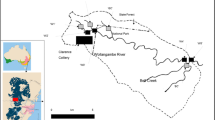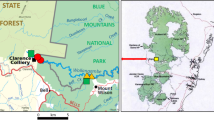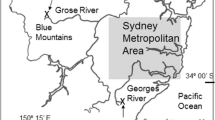Abstract
Ineffective environmental regulation of effluent discharged from an underground coal mine operation has enabled water pollution within two highly valued Australian rivers. This study investigated the impacts on water chemistry of the Bargo and Nepean rivers as a result of the continuous disposal of mine effluent from Tahmoor Colliery over a 14-month period. Coal mine effluent was saline (2180 μS/cm) and alkaline (8.7 pH), and strongly modified the ionic composition within both rivers. Ecologically hazardous concentrations of several metals were found in mine effluent, including aluminium (858 μg/L), arsenic (59.7 μg/L), nickel (60.7 μg/L), and zinc (49.4 μg/L). The effluent also contained elevated total nitrogen (2.89 mg/L) and the waste discharge contributed 67% of the median flow volume in the Bargo River below the discharge point. The plume of saline- and metal-enriched contamination extended at least 9 km downstream past the discharge point, impairing water quality in both the Bargo and Nepean rivers. This study reveals more than a decade of ineffective regulatory and governance systems that enable Tahmoor Colliery to continually release inadequately treated mine effluent.










Similar content being viewed by others
Data Availability
Not applicable.
References
AECOM (2018). Tahmoor coal environmental impact statement – main report. https://majorprojects.planningportal.nsw.gov.au/prweb/PRRestService/mp/01/getContent?AttachRef=SSD-8445%2120190328T225833.432%20GMT. Accessed 10 September 2020.
Ali, A., Strezov, V., Davies, P., & Wright, I. (2017). Environmental impact of coal mining and coal seam gas production on surface water quality in the Sydney basin, Australia. Environmental Monitoring and Assessment, 189(8), 408–424.
Ali, A., Sloane, D., & Strezov, V. (2018). Assessment of impacts of coal mining in the region of Sydney, Australia on the aquatic environment using macroinvertebrates and chlorophyll as indicators. International Journal of Environmental Research and Public Health, 15(7), 1556–1571.
ANZECC (Australian and New Zealand Environment and Conservation Council). (2000). Australian and New Zealand guidelines for fresh and marine waters. Canberra: Australian and New Zealand Environment and Conservation Council https://www.waterquality.gov.au/sites/default/files/documents/anzecc-armcanz-2000-guidelines-vol1.pdf. Accessed 10 September 2020.
APHA (American Public Health Association). (1998). Standard methods for the examination of water and wastewater (20th ed.). Washington, DC: American Public Health Association.
Aral, H., & Vecchio-Sadus, A. (2008). Toxicity of lithium to humans and the environment – a literature review. Ecotoxicology and Environmental Safety, 70, 349–356.
Banks, D., Younger, P. L., Arnesen, R.-T., Iversen, E. R., & Banks, S. B. (1997). Mine-water chemistry: the good, the bad and the ugly. Environmental Geology, 32(3), 157–174.
Battaglia, M., Hose, G. C., Turak, E., & Warden, B. (2005). Depauperate macroinvertebrates in a mine affected stream: clean water may be the key to recovery. Environmental Pollution, 138(1), 132–141.
Belmer, N., & Wright, I. A. (2019). Regional comparison of impacts to stream macroinvertebrates from active and inactive coal mine wastewater discharges, Sydney Basin, New South Wales Australia. American Journal of Water Science and Engineering, 5(2), 62–75.
Belmer, N., & Wright, I. A. (2020). The regulation and impact of eight Australian coal mine wastewater discharges on downstream river water quality: a regional comparison of active versus closed mines. Water Environment Journal, 34(3), 350–363.
Belmer, N., Paciuszkiewicz, K., & Wright, I. A. (2019). Regulated coal mine wastewater contaminants accumulating in an aquatic predatory beetle (Macrogyrus rivularis): Wollangambe River, Blue Mountains New South Wales Australia. American Journal of Water Science and Engineering, 5(2), 76–87.
Bharti, S., & Banerjee, T. K. (2011). Bioaccumulation of metals in the edible catfish Heteropneustes fossilis (Bloch) exposed to coal mine effluent generated at Northern Coalfield Limited, Singrauli, India. Bulletin of Environmental Contamination and Toxicology, 87, 393–398.
BOM (2021) Australian Government Bureau of Meteorology. Climate data online. Camden Airport AWS Station Number 68192. http://www.bom.gov.au/climate/data/?ref=ftr. Accessed 6 January 2021.
Brake, S., Connors, K., & Romberger, S. (2001). A river runs through it: impact of acid mine drainage on the geochemistry of West Little Sugar Creek pre- and post-reclamation at the Green Valley coal mine, Indiana, USA. Environmental Geology, 40(11/12), 1471–1481.
Burger, A., & Lichtscheidl, I. (2019). Strontium in the environment: review about reactions of plants towards stable and radioactive strontium isotopes. Science of the Total Environment, 653, 1458–1512.
CSIRO and BOM (Bureau of Meteorology) (2020). State of the climate 2020. Australian Government. Available at: (http://www.bom.gov.au/state-of-the-climate/). Accessed 11 Feb 2021.
Cunningham, M., Van Uffelen, L., & Chambers, M. (2019). The changing global market for Australian coal. Reserve Bank of Australia. https://www.rba.gov.au/publications/bulletin/2019/sep/the-changing-global-market-for-australian-coal.html. Accessed 8 January 2021.
Daniel, M. F., Brereton, D., & Moran, C. J. (2010). Managing the cumulative impacts of coal mining on regional communities and environments in Australia. Impact Assessment and Project Appraisal, 28, 299–312.
DPIE (2020) NSW Department of Planning, Industry and Environment. Tahmoor South Coal Project State Significant Development. Environmental Impact Statement https://www.planningportal.nsw.gov.au/major-projects/project/10966. Accessed 17 October 2020.
EPL 10555 (2021). Environment Protection Licence # 10555. Sydney Water Corporation. Picton Sewerage Treatment System. https://apps.epa.nsw.gov.au/prpoeoapp/ViewPOEOLicence.aspx?DOCID=31619&SYSUID=1&LICID=10555 Accessed 8 January 2021
EPL 1389 (2021). Environment Protection Licence # 1389 Tahmoor Coal. Tahmoor Colliery. https://apps.epa.nsw.gov.au/prpoeoapp/ViewPOEOLicence.aspx?DOCID=201734&SYSUID=1&LICID=1389 Accessed 8 January 2021.
García-Criado, F., Tomé, A., Vega, F., & Antolín, C. (1999). Performance of some diversity and biotic indices in rivers affected by coal mining in northwestern Spain. Hydrobiologia, 394(1), 209–217.
Geoscience Australia (2013) Australia’s Mineral Resource Assessment 2013. https://www.ga.gov.au/data-pubs/data-and-publications-search/publications/australian-minerals-resource-assessment. Accessed 17 October 2020.
Giam, X., Olden, J. D., & Simberloff, D. (2018). Impact of coal mining on stream biodiversity in the US and its regulatory implications. Nature Sustainability, 1(4), 176–183.
Golding, L. A., McKnight, K., Adams, M., & Apte, S. (2018). Toxicity of dissolved and precipitated forms of barium to a freshwater alga (Chlorella sp.12) and water flea (Ceriodaphnia dubia). Environmental Toxicology and Chemistry, 37, 1632–1642.
Gombert, P., Sracek, O., Koukouzas, N., Gzyl, G., Valladares, S., Frączek, R., Klinger, C., Bauerek, A., Areces, A. J. E. A., Chamberlain, S., Paw, K., & Pierzchala, L. (2018). An overview of priority pollutants in selected coal mine discharges in Europe. Mine Water and the Environment, 38, 16–23.
Graham, K., & Wright, I. A. (2012). The potential and reality of the environment protection licensing system in New South Wales: the case of water pollution. Environmental and Planning Law Journal, 29(5), 359–372.
Gray, D. P., & Harding, J. S. (2012). Acid Mine Drainage Index (AMDI): a benthic invertebrate biotic index for assessing coal mining impacts in New Zealand streams. New Zealand Journal of Marine and Freshwater Research, 46(3), 335–352.
Griffith, M. B., Norton, S. B., Alexander, L. C., Pollard, A. I., & LeDuc, S. D. (2012). The effects of mountaintop mines and valley fills on the physicochemical quality of stream ecosystems in the central Appalachians: a review. Science of the Total Environment, 417–418, 1–12.
Hart, B. T., & McKelvie, I. D. (1986). Chemical limnology in Australia. In W. D. Williams & P. De Deckker (Eds.), Limnology in Australia (pp. 3–31). CSIRO Publishing: Collingwood.
Hawkesbury-Nepean River Health Strategy (2007) Hawkesbury-Nepean catchment management authority. Appendix 4.2 Bargo River subcatchment. https://archive.lls.nsw.gov.au/__data/assets/pdf_file/0008/496772/archive-bargo-river-subcatchment.pdf Accessed 5 January 2020.
Healthy Rivers Commission of New South Wales. (1998). Independent inquiry into the Hawkesbury-Nepean River system: final report August 1998. Sydney: Healthy Rivers Commission of New South Wales.
Horrigan, N., Choy, S., Marshall, J., & Recknagel, F. (2005). Response of stream macroinvertebrates to changes in salinity and the development of a salinity index. Marine and Freshwater Research, 56(6), 825–833.
Huleatt, M. B. (1991). Handbook of Australian black coals: geology, resources, seam properties, and product specifications. Bureau of Mineral Resources, Canberra, Australia, Resource Report No., 7.
Jain, C. K., & Ali, I. (2000). Arsenic: occurrence, toxicity and speciation techniques. Water Research, 34(17), 4304–4312.
Jarvis, A. P., & Younger, P. L. (1997). Dominating chemical factors in mine water induced impoverishment of the invertebrate fauna of two streams in the Durham Coalfield, UK. Chemistry and Ecology, 13(4), 249–270.
Johnson, D. B. (2003). Chemical and microbiological characteristics of mineral spoils and drainage waters at abandoned coal and metal mines. Water, Air, & Soil Pollution: Focus, 3, 47–66. https://doi.org/10.1023/A:1022107520836.
Krogh, M. (2007). Management of longwall coal mining impacts in Sydney’s southern drinking water catchments. Australasian Journal of Environmental Management, 14(3), 155–165.
Lake, P. S. (2003). Ecological effects of perturbation by drought in flowing waters. Freshwater Biology, 48, 1161–1172.
Lattuada, R. M., Menezes, C. T. B., Pavei, P. T., Peralba, M. C. R., & Dos Santos, J. H. Z. (2009). Determination of metals by total reflection X-ray fluorescence and evaluation of toxicity of a river impacted by coal mining in the south of Brazil. Journal of Hazardous Materials, 163(2), 531–537.
Markich, S. J., & Brown, P. L. (1998). Relative importance of natural and anthropogenic influences on the fresh surface water chemistry of the Hawkesbury–Nepean River, south-eastern Australia. Science of the Total Environment, 217(3), 201–230.
Markich, S. J., Brown, P. L., Bately, G. E., Apte, S. C., & Stauber, J. L. (1998). Incorporating metal speciation and bioavailability into water quality guidelines for protecting aquatic ecosystems. Australian Journal of Ecotoxicology, 7, 109–122.
McPherson, C. A., Lawrence, G. S., Elphick, J. R., & Chapman, P. M. (2014). Development of a strontium chronic benchmark for aquatic life in freshwater. Environmental Toxicology and Chemistry, 33, 2472–2478.
Morrison, K. G., Reynolds, J. K., Belmer, N., & Wright, I. A. (2019). Ecological and geochemical impact of an underground colliery waste discharge to a river. IOP Conference Series: Earth and Environmental Science, 344, 012003.
Mosley, L. M. (2015). Drought impacts on the quality of freshwater systems; review and integration. Earth-Science Reviews, 140, 203–214.
Mudd, G. M. (2009). The sustainability of mining in Australia: key production trends and their environmental implications for the future. Research Report No RR5, Department of Civil Engineering, Monash University and Mineral Policy Institute. http://users.monash.edu.au/~gmudd/files/SustMining-Aust-Report-2009-Master.pdf. Accessed 10 September 2020.
Murdoch, P. S., Baron, J. S., & Miller, T. L. (2000). Potential effects of climate chance on surface water quality in North America. Journal of the American Water Resources Association, 36, 347–366.
NSW Auditor-General (2018) Audit Office of NSW. Regulation of water pollution in drinking water catchments and illegal disposal of solid waste. https://www.audit.nsw.gov.au/our-work/reports/regulation-of-water-pollution-in-drinking-water-catchments-and-illegal-disposal-of-solid-waste. Accessed 10 September 2020.
NSW EPA (2011). NSW Environment Protection Authority. EPL 1389 Notice 1502304. Notice of variation of licence 1389. https://apps.epa.nsw.gov.au/prpoeoapp/Detail.aspx?instid=1389&id=1502304&option=notice&range=POEO%20licence¬icetype=. Accessed 8 January 2021.
NSW EPA (2017). Variation to an environment protection licence for Clarence Colliery. http://www.epa.nsw.gov.au/licensing/clarence-colliery.htm. Accessed 28 Sep 2020.
NSW National Parks and Wildlife Service (2015) Bargo River State Conservation Area. https://www.environment.nsw.gov.au/-/media/OEH/Corporate-Site/Documents/Parks-reserves-and-protected-areas/Parks-plans-of-management/bargo-river-state-conservation-area-plan-of-management-160131.pdf. Accessed 29 September 2020
Parkhurst, D.L., and Appelo, C.A.J. (2013). Description of input and examples for PHREEQC version 3—a computer program for speciation, batch-reaction, one-dimensional transport, and inverse geochemical calculations: U.S. Geological Survey Techniques and Methods, Book 6, chap. A43, 497 p. https://pubs.usgs.gov/tm/06/a43/. Accessed 8 January 2021
Pinto, U. & Maheshwari, B. (2015). Community perspectives on managing health of peri-urban river system: evidence from the Hawkesbury-Nepean river catchment, Australia, Journal of Environmental Planning and Management. 1-20. DOI: https://doi.org/10.1080/09640568.2015.1067599.
POEO Act (2018) Protection of the Environment Operations Act (1997) NSW. https://www.legislation.nsw.gov.au/#/view/act/1997/156 Accessed 8 January 2021
Pond, G. J. (2010). Patterns of Ephemeroptera taxa loss in Appalachian headwater streams (Kentucky, USA). Hydrobiologia, 641(1), 185–201.
Pond, G. J., Passmore, M. E., Borsuk, F. A., Reynolds, L., & Rose, C. J. (2008). Downstream effects of mountaintop coal mining: comparing biological conditions using family- and genus-level macroinvertebrate bioassessment tools. Journal of the North American Benthological Society, 27(3), 717–737.
Price, P., & Wright, I. A. (2016). Water quality impact from the discharge of coal mine wastes to receiving streams: comparison of impacts from an active mine with a closed mine. Water, Air, & Soil Pollution, 227(5), 1–17.
Prosser, I. P. (2011). Water: science and solutions for Australia. Collingwood: Published by CSIRO PUBLISHING.
Rich, S. (2016). Troubled water: an examination of the NPDES permit shield. Pace Environmental Law Review, 33(2 Winter 2016), article 3.
Strosnider, W. H. J., Hugo, J., Shepherd, N. L., Holzbauer-Schweitzer, B. K., Hervé-Fernández, P., Wolkersdorfer, C., & Nairn, R. W. (2020). A snapshot of coal mine drainage discharge limits for conductivity, sulfate, and manganese across the developed world. Mine Water and the Environment, 39, 165–172.
Sydney Catchment Authority (2015) Nepean River daily flow data for station number 212208 (Maldon Weir) Dataset https://data.gov.au/data/dataset/019128a1-d747-4ac2-842d-c0b30a4f8627. Accessed 5 January 2021
Sydney Water (2018) Sewage treatment system impact monitoring program interpretive report 2016-17 trends in WWTP nutrient loads and water quality of the Hawkesbury-Nepean River. https://www.sydneywater.com.au/web/groups/publicwebcontent/documents/document/zgrf/mtk5/~edisp/dd_199230.pdf Accessed 5 January 2021
Tahmoor Coal. (2019). Annual review/environmental management report 2019. http://www.simec.com/media/6953/tahmoor-coal-2019-annual-review-and-aemr_final.pdf Accessed 17 October 2020
Tiwary, R. K. (2001). Environmental impact of coal mining on water regime and its management. Water, Air, and Soil Pollution, 132(1), 185–199.
USEPA (2020) United States Environmental Protection Agency. Summary of the Clean Water Act. Available at: https://www.epa.gov/laws-regulations/summary-clean-water-act. Accessed 15 Feb 2021.
Verb, R. G., & Vis, M. L. (2000). Comparison of benthic diatom assemblages from streams draining abandoned and reclaimed coal mines and nonimpacted sites. Journal of the North American Benthological Society, 19(2), 274–288.
Williams , D. R., M. E. Clark & Brown, J. B. (1999). Stream water quality in coal mined areas of the lower Cheat River basin, West Virginia and Pennsylvania, during low-flow conditions, July 1997. Water-Resources Investigations Report 98-4258, U. S. Geological Survey.
Winterbourn, M. J. (1998). Insect faunas of acidic coal mine drainages in Westland, New Zealand. New Zealand Entomologist, 21(1), 65–72. https://doi.org/10.1080/00779962.1998.9722038.
Wollondilly Shire Council (2020). Integrated water management strategy. https://www.yoursay.wollondilly.nsw.gov.au/integrated-water-management-strategy. Accessed 8 January 2021.
Wright, I. A. (2012). Coal mine “dewatering” of saline wastewater into NSW streams and rivers: a growing headache for water pollution regulators. Proceedings of the 6th Australian Stream Management Conference, Managing for Extremes, 6-8 February, 2012 Canberra, Australia, 206–213.
Wright, I. A., & Burgin, S. (2009a). Comparison of sewage and coal-mine wastes on stream macroinvertebrates within an otherwise clean upland catchment, southeastern Australia. Water, Air, and Soil Pollution, 204(1–4), 227–241.
Wright, I. A., & Burgin, S. (2009b). Effects of organic and heavy metal pollution on chironomids within a pristine upland catchment. Hydrobiologia, 635(1), 15–25.
Wright, I. A., & Ryan, M. M. (2016). Impact of mining and industrial pollution on stream macroinvertebrates: importance of taxonomic resolution, water geochemistry and EPT indices for impact detection. Hydrobiologia, 772(1), 103–115.
Wright, I. A., Wright, S., Graham, K., & Burgin, S. (2011). Environmental protection and management: a water pollution case study within the Greater Blue Mountains World Heritage Area, Australia. Land Use Policy, 28(1), 353–360.
Wright, I. A., McCarthy, B., Belmer, N., & Price, P. (2015). Subsidence from an underground coal mine and mine wastewater discharge causing water pollution and degradation of aquatic ecosystems. Water, Air, & Soil Pollution, 226(10), 348–362.
Wright, I. A., Belmer, N., & Davies, P. J. (2017). Coal mine water pollution and ecological impairment of one of Australia’s most ‘protected’ high conservation-value rivers. Water, Air, & Soil Pollution, 228(3), 90–108.
Wright, I. A., Paciuszkiewicz, K., & Belmer, N. (2018). Increased water pollution after closure of Australia’s longest operating underground coal mine: a 13-month study of mine drainage, water chemistry and river ecology. Water, Air, & Soil Pollution, 229(3), 55–75.
Younger, P. L. (1993). Possible environmental impact of the closure of two collieries in County Durham. Water Environment Journal, 7(5), 521–531.
Younger, P. L. (2004). Environmental impacts of coal mining and associated wastes: a geochemical perspective. Geological Society, London, Special Publications, 236(1), 169–209.
Zrinka, D., Tepić, N., Ramani, S., Krasnići, N., Marijić, V. F., Valić, D., Kapetanović, D., Erk, M., Rebok, K., Kostov, V., & Jordanova, M. (2019). Mining waste as a cause of increased bioaccumulation of highly toxic metals in liver and gills of Vardar chub (Squalius vardarensis Karaman, 1928). Environmental Pollution, 247, 564–576.
Zwolsman, J.J.G.; Vliet, M.T.H. van; Bonte, M.; Gorski, N.; Flörke, M.; Eisner, S.; & Ludwig, F. (2011). Water for utilities: climate change impacts on water quality and water availability for utilities in Europe Wageningen Universiteit, (Technical report / WATCH no. 55). Available at: (https://library.wur.nl/WebQuery/wurpubs/418562).
Younger, P. L. (2001). Mine water pollution in Scotland: nature, extent and preventative strategies. The Science of the Total Environment, 265, 309–326.
Acknowledgements
Western Sydney University provided laboratory and technical support for the research. The senior author undertook this research as part of his Masters of Research study. We thank Michael Franklin and Sue Cusbert for their technical assistance.
Code Availability
Not applicable.
Author information
Authors and Affiliations
Contributions
All authors made substantial contributions to all parts of this research.
Corresponding author
Ethics declarations
Conflict of Interest
The authors declare no conflict of interest.
Additional information
Publisher’s Note
Springer Nature remains neutral with regard to jurisdictional claims in published maps and institutional affiliations.
Rights and permissions
About this article
Cite this article
Fleming, C., Morrison, K., Robba, L. et al. 14-Month Water Quality Investigation of Coal Mine Discharge on Two Rivers in NSW, Australia: Implications for Environmental Regulation. Water Air Soil Pollut 232, 90 (2021). https://doi.org/10.1007/s11270-021-05020-7
Received:
Accepted:
Published:
DOI: https://doi.org/10.1007/s11270-021-05020-7




